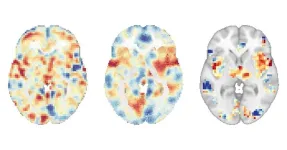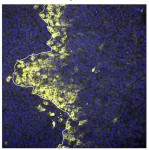From Ecology:
Some pathogens can’t take the heat
Author contact: Emily L. Bruns (ebruns@umd.edu)
Pathogens, parasites and other scourges are generally expected to benefit from climate change at the expense of their hosts, but new research suggests that higher temperatures could instead provide relief for some hosts. Focusing on a fungus that infects the common wildflower white campion, researchers at the University of Maryland found that temperatures exceeding 30°C greatly inhibited the fungus but had little effect on the wildflower — an indication that the plant is more tolerant of heat than the fungus. Moreover, seedlings’ susceptibility to infection and fungal activity in diseased plants were also curtailed as temperatures rose, which slowed the spread of the fungus among plants. The results of the experiments show that, under the warmer conditions of the future, occasionally the host and not its pathogen will be the one to beat the heat.
Read the article: High temperatures reduce growth, infection, and transmission of a naturally occurring fungal plant pathogen
Bottom-up factors steer seabird dynamics at the bottom of the world
Author contact: Lise Viollat (lise.viollat@protonmail.fr)
Models built on 31 years of data show that the population dynamics of an Antarctic predatory seabird and the two penguin species it preys upon are shaped by food availability and physical conditions, according to a French research team. Unsurprisingly, abundant prey (measured as Adélie penguin breeding pairs and dead emperor penguin chicks) boosted breeding success of the predatory south polar skua. However, skua abundance had little impact on penguin numbers. Populations of both predator and prey were also dependent on prevailing environmental conditions. Extensive sea-ice sheets impeded Adélie foraging, which reduced penguin breeding success and abundance. Fewer penguin chicks meant less food for skuas and their offspring. Discerning the drivers of predator–prey population dynamics at the poles is especially critical given the speed of climate change in these regions.
Read the article: Bottom-up effects drive the dynamic of an Antarctic seabird predator–prey system
From Frontiers in Ecology and the Environment:
In Africa, modern housing may be a draw for unwanted houseguests
Author contact: Tamika Lunn (tamika.lunn@uga.edu)
New research highlights an unexpected consequence of housing improvements in Africa: they create prime habitats for free-tailed bats. Across rural southern Kenya, the bats are taking up residence in modern-style buildings, especially those with triangular roofs. In a study of over 1,100 buildings, nearly one in ten showed signs of bat occupation, with modern buildings being five times more likely to host bats than other structures. Given that bats are known to harbor a wide variety of viruses, including pathogens that pose a grave danger to people, the close proximity of bats and humans presents a growing health risk. To mitigate this risk, the study authors call for preemptive bat-proofing of homes and restoration of natural bat habitats. By sealing bat entry points and improving housing design, communities can reduce human-bat contact and help prevent the spread of zoonotic diseases — without sacrificing the benefits of modern housing.
Read the article: Modern building structures are a landscape-level driver of bat–human exposure risk in Kenya
From Ecosphere:
Size, structure and supporting cast determine coral reef recovery
Author contact: Mollie Asbury (masbury@hawaii.edu)
Coral reefs face growing pressure from fishing and disturbances like marine heatwaves and disease, and a new study demonstrates how different combinations of these pressures impact reef recovery — sometimes in surprising ways. Model simulations of three disturbance patterns under conditions of high and low fishing intensity revealed that destruction of big, highly productive corals (as might occur during a tropical storm) reduced the potential for reefs to rebound. In addition, recovery was further inhibited by heavy fishing, as many reef fishes play roles in nutrient cycling and feed on algae that, in their absence, can quickly overgrow reefs. Finally, complex reef structures were found to be more resilient to disturbance than simpler configurations. The results underscore the need for improving understanding of how reef organization and fishing pressures influence reef recovery following disturbance as human-related impacts increase globally.
Read the article: Recovery potential of fish and coral populations following ecological disturbance
Ticks and the city
Author contact: Jonathan Bastard (jonathan.bastard@anses.fr)
New research on urban tick populations in New York City reveals how human infrastructure and urban wildlife influence tick presence and the risk of tick-borne diseases. The study shows that features of residential yards, such as fences, can alter the movement of mammals like raccoons and deer, which carry ticks into these areas. White-tailed deer were found to introduce blacklegged ticks, known for carrying Lyme disease, into yards. Meanwhile, raccoons helped spread lone star ticks. Surprisingly, some residential sites had higher mammal diversity than nearby natural greenspaces, challenging assumptions that biodiversity loss in cities always increases disease risk. By pinpointing how landscapes and wildlife behavior influence tick spread, the research offers insights into managing tick-borne disease risks in cities.
Read the article: Cascading effects of mammal host community composition on tick vector occurrence at the urban human–wildlife interface
From Ecological Monographs:
What do we mean when we talk about eutrophication?
Author contact: Alexandrine Pannard (alexandrine.pannard@univ-rennes.fr)
For over a century, aquatic ecologists have puzzled over watery habitats that become murky and turbid from the growth of plants, algae and microbes – a process broadly called “eutrophication.” But when scientists use the word “eutrophication,” are they all referring to the same thing? Drawing from the scientific literature as far back as 1947, the authors of a new study sorted 138 definitions of eutrophication into three broad categories, based on whether they were primarily generic explanations, focused on the species involved or related to management and regulation issues. Substituting the more descriptive term “nutrient pollution” would make it easier for nonspecialists to grasp the process while underscoring the human role, propose the authors, with the term “eutrophication” reserved for use in scientific circles addressing technical aspects. Coming to a consensus is more than a semantic exercise, say the authors; the need for clear language is increasingly urgent as global environmental change takes its toll on aquatic ecosystems.
Read the article: Why are there so many definitions of eutrophication?
From Ecological Applications:
Dodging an aquatic invader
Author contact: Teun Everts (teun.everts@inbo.be)
Invasive species’ impacts are hard to predict, but a new study points to an aspect of amphibian biology that can help forecast which native species are the most vulnerable when an invader moves in. The research, which focuses on invasive American bullfrogs in Belgium, reveals that native amphibians with breeding cycles closely aligned with bullfrogs are at greater risk of decline. For dozens of ponds, the research team used environmental DNA — essentially, DNA detected in water samples — to find out which amphibians called the ponds home and how infested with bullfrogs they were. The findings indicated that ponds with the greatest numbers of bullfrogs often had fewer native species, but not all native amphibians were equally hard hit. In particular, late spring- and summer-breeding species, which were more likely to encounter the summer-breeding bullfrogs, tended to decline in bullfrog-infested ponds. Winter-breeding amphibians, on the other hand, were largely unaffected by the invaders. The research suggests that native biodiversity that can avoid invasive species in time, if not in space, may fare better.
Read the article: Phenological mismatches mitigate the ecological impact of a biological invader on amphibian communities
###
The Ecological Society of America, founded in 1915, is the world’s largest community of professional ecologists and a trusted source of ecological knowledge, committed to advancing the understanding of life on Earth. The 8,000 member Society publishes seven journals including a membership bulletin and broadly shares ecological information through policy, media outreach and education initiatives. Visit the ESA website at https://www.esa.org
The Society’s Annual Meeting attracts 4,000 attendees and features the most recent advances in ecological science. The program and recorded content from last month’s 2024 Meeting in Long Beach, California are available for viewing until summer 2025; members of the press and institutional press officers are invited to contact Public Affairs Manager Mayda Nathan gro.ase@adyam for free access.
Follow ESA on social media:
Twitter/X – @esa_org
Instagram – @ecologicalsociety
Facebook – @esa.org
END





